Elite life

Mushrooms
Suillus
║ Mushrooms ║
Chicken-Fat Suillus (Suillus americanus)

Cap 3-10 cm across, broadly convex with a low umbo and incurved margin, which may have remnants of a yellowish, cottony veil hanging from it; bright yellow with red or brownish streaks and hairy patches; slimy and sticky. Tubes adnate to decurrent; yellow, staining reddish brown when bruised. Pores large, angular; yellow becoming darker with age. Stem 30-90 x 4-l0 mm, often crooked, becoming hollow; lemon yellow with dots that bruise darker, as do other parts of stem if handled. Veil partial veil, not attached to stalk, leaves no ring on stem. Flesh mustard yellow, staining pinky-brown when bruised. Spores ellipsoid to subfusoid, 8-11x3-4 μm. Deposit dull cinnamon.
Short-Stalked Suillus (Suillus brevipes)
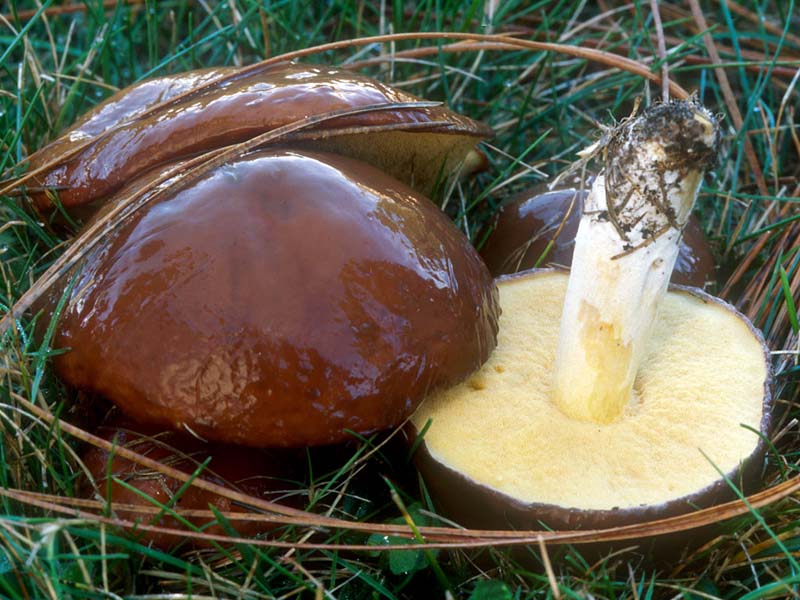
Cap: 5-10 cm; convex becoming broadly convex or flat; slimy; smooth; dark brown to yellow brown, cinnamon, or rust-brown, fading to dull cinnamon and sometimes in age a dingy yellowish brown; margin incurved at first, sometimes lobed with age.
Pore Surface: Pale yellow, darkening to dingy yellow and finally olive brown; 1-2 circular pores per mm; tubes to about 1 cm deep.
Stem: 2-7 cm long; 1-2 cm thick; typically short; equal to slightly enlarged below; white at first, becoming pale yellow; glandular dots absent or not well developed; without a ring.
Flesh: Thick; white, becoming yellow in age; soft; not staining when sliced.
Spore Print: Brown to dull cinnamon.
Spores 7-10 x 3 μm; smooth; subfusoid.
Dotted-Stalk Suillus (Suillus granulatus)

Cap: 5-15 cm; convex becoming broadly convex; sticky or slimy; smooth; variable in color but typically buff, yellowish, or pale cinnamon at first, becoming darker cinnamon brown or orangish brown; often with the color breaking up in maturity to form a patchwork pattern; without partial veil remnants.
Pore Surface: Whitish at first; soon yellowish; often with droplets of cloudy liquid when young; not bruising, or bruising and spotting cinnamon to brownish; pores about 1 mm wide at maturity; not strongly boletinoid but sometimes weakly so in age; tubes about 1 cm deep.
Stem: 4-8 cm long; 1-2 cm thick; equal or with a tapering base; with tiny, tan or brownish glandular dots on the upper half; without a ring; white, developing bright yellow shades near the apex or overall.
Flesh: White at first, but soon pale yellow; not staining on exposure.
Spore Print: Cinnamon brown to brown.
Spores 7-9 x 2.5-3.5 μm; smooth; subfusoid.
Larch Suillus, Larch Bolete (Suillus grevillei)
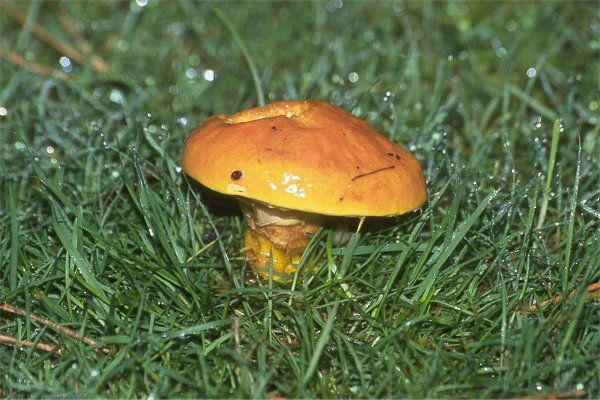
Suillus grevillei is a mushroom with 5-10 cm cap colored from citrus yellow to burnt orange, that is at first hemispherical, then bell-shaped, and finally flattened. It has a sticky cuticle, short tubes of yellow or brownish which descend down to the bottom of its cylindrical stalk (6-10x1-2 cm) which is cream-colored turning to reddish brown with a cream-white ring.It has a thin meat which has consistency at first but then quickly becomes soft. It has an odor reminiscent of rumpled geranium leaves.
Slippery Jack (Suillus luteus)
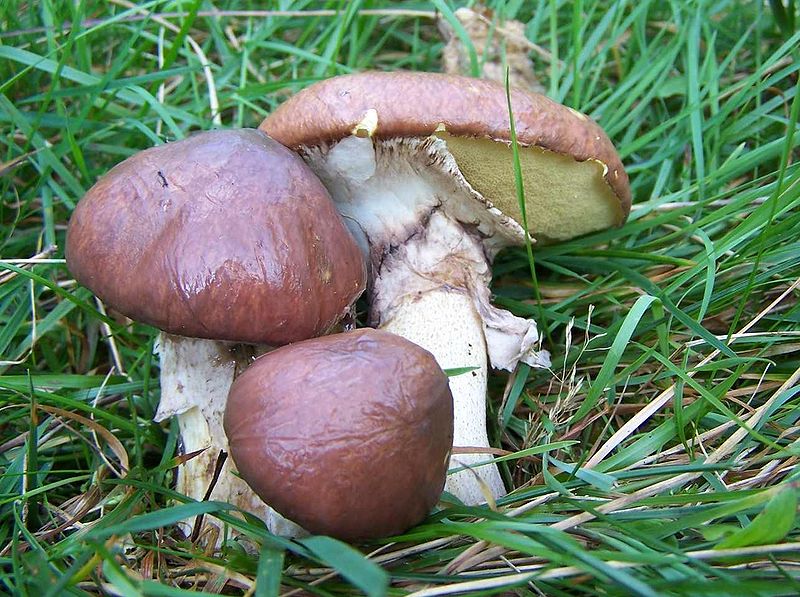
Cap: 5-12 cm; convex when young, becoming broadly convex to flat; slimy; shiny when dry; partial veil tissue often hanging from the margin; dark brown to dark reddish brown to yellow brown; fading with age.
Pore Surface: Covered with a whitish partial veil when young; whitish to pale yellow, becoming yellow to olive yellow with age; not bruising; pores under 1 mm across; tubes 4-15 mm deep.
Stem: 3-8 cm long; 1-2.5 cm thick; equal; with glandular dots above the ring; whitish, yellowish towards apex; discoloring brown to purplish brown near the base in age; with a flaring white ring that develops purple shades on the underside and is often gelatinous in humid or wet weather.
Flesh: White to pale yellow; not staining on exposure.
Spores 7-9 x 2.5-3 μm; smooth; subfusoid.
Pungent Suillus (Suillus pungens)
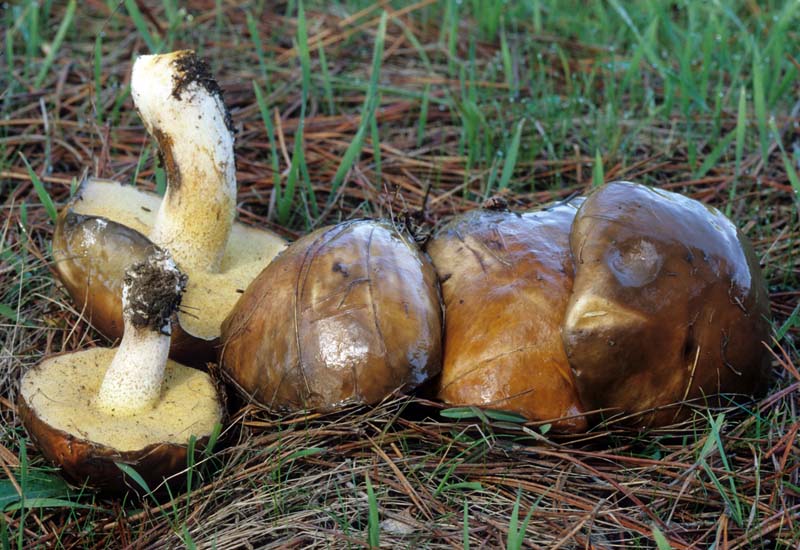
Pileus: Cap 5-13 cm broad, convex, nearly plane in age; margin incurved when young with cottony, white velar tissue; surface viscid, smooth, white, becoming grey with olive tones, at maturity various combinations of rusty-brown, reddish-brown or a dull yellowish-brown, the latter typical of old fruiting bodies; flesh white, turning yellow at maturity, not bruising blue; odor and taste fruity but harsh.
Hymenophore: Pores at first white to cream, exuding white droplets in moist weather; in age pores yellowish to dingy, yellow-brown, not bruising blue.
Stipe: Stipe 3-8 cm tall, 1.5-2.0 cm thick, equal, sometimes tapering slightly to the base; surface dry, white to pale yellow, dotted with buff-colored glands that at maturity become dark-brown; flesh not bruising blue.
Spores: Spores 9-10 x 3-3.5 μm, elliptical, smooth; spore print brown.
Slippery Jill (Suillus subluteus, Suillus salmonicolor)
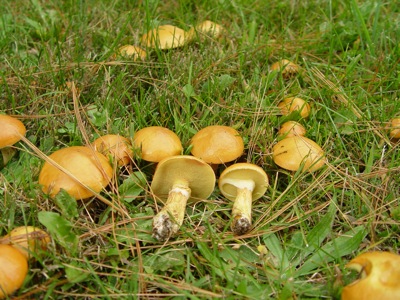
Cap: 3-10 cm; convex becoming broadly convex or flat; slimy; smooth; orangish, dirty yellowish, brownish, olive brown, or cinnamon.
Pore Surface: At first covered with a thick, orangish to grayish partial veil that is baggy and rubbery, with a white roll of tissue on the lower edge; yellow to orangish, becoming brownish with age; not bruising; 1-2 round or angular pores per mm; not boletinoid; tubes to about 1 cm deep.
Stem: 3-10 cm long; up to 1.5 cm thick; equal or with a slightly enlarged base; covered with glandular dots that are pale reddish brown at first and become darker with age; whitish to yellowish or orangish; with a gelatinous ring.
Flesh: Orangish to yellowish, often salmon orange in the stem base; not staining on exposure.
Spore Print: Cinnamon brown or brown.
Spores 7-10 x 3-3.5 μm; smooth; subfusoid.
Tomentose Suillus (Suillus tomentosus)
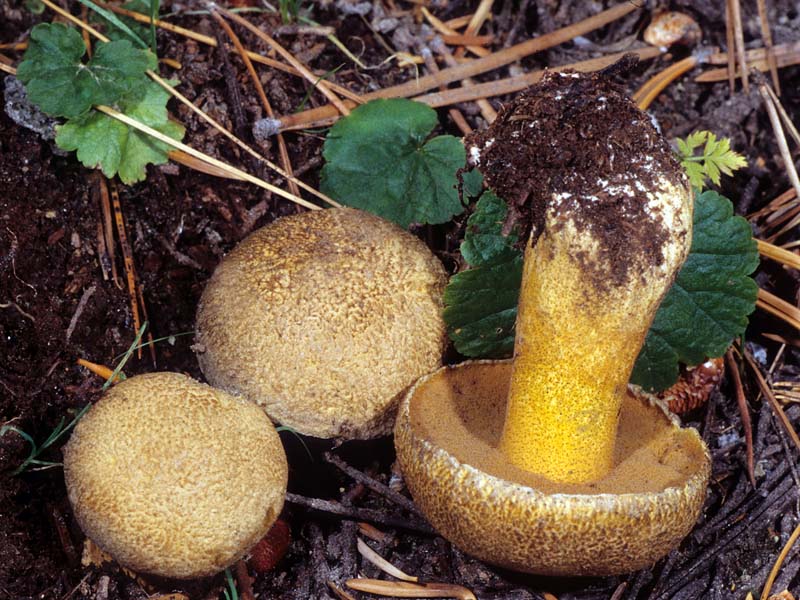
Pileus: Cap 5-11 cm broad, convex, broadly convex in age; margin at first incurved, decurved at maturity; surface viscid when moist, pale yellow to dingy-buff, tomentose, becoming squamose, occasionally weathering to nearly smooth; scales typically greyish to olive-grey, sometimes reddish in cold weather; flesh thick, soft, white to pale yellow, bluing slowly when injured; odor, mild to fruity/harsh; taste mild.
Hymenophore: Tubes up to 1.5 cm long, dingy yellowish-olive, slowly bluing when cut, adnate to depressed at the stipe; pores approximately 1/mm, angular, dull brown, becoming dingy ochre at maturity, bluing slowly when bruised.
Stipe 5-9 cm. long, 1.5-3.0 cm thick, solid, equal or enlarged at the base; surface sticky, yellowish to apricot-orange at the apex, sometimes tinged dull reddish-brown at the base, dotted with brown glandulae; context like the cap, i.e. pallid to pale yellow, usually bruising blue slowly; veil absent.
Spores 8-11x3-4 μm, narrowly elliptical to subfusiform, smooth, thin-walled; spore print dark olive-brown.
║ Mushrooms ║